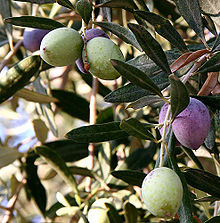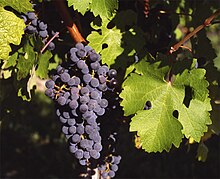Ancient Israelite cuisine
Dietary staples among the Israelites were bread, wine, and olive oil; also included were legumes, fruits and vegetables, dairy products, fish, and meat.
[5] Archaeologists have found the carbonized seeds of two kinds of primitive wheat, einkorn and emmer, and two-row barley, in the earliest levels of digs at Jericho, one of the first cities in the world.
[7] The Israelite presence emerged during the Early Iron Age (1200-1000 BCE), at first in the central hill country, Transjordan and the northern Negev, and later in the Galilee, while the Philistines and other Sea Peoples arrived at roughly the same time and settled in the coastal regions.
[7] The ancient Israelites depended on bread, wine and oil as the basic dietary staples[9] and this trio is often mentioned in the Bible (for example, Deut 7:13 and 2 Kings 18:32) and in other texts, such as the Samaria and Arad ostraca.
[9] An Israelite meal is illustrated by the biblical description of the rations that Abigail brought to David’s group: bread loaves, wine, butchered sheep, parched grain, raisins, and fig cakes (1 Samuel 25:18).
[28] Barley was initially predominant because it matured earlier and tolerated harsher conditions than wheat, growing in areas with less rainfall and poorer soils, such as northern Negev and the hill country.
[10] It was presumably made from dough that was a simple mixture of barley flour and water, divided into small pieces, formed by hand into round shapes, then baked.
Durum grew well in the rich soil of the larger valleys of the central and northern areas of the country, where rainfall exceeded 225 millimeters per year, was higher yielding than emmer, and its grains released more easily from the chaff.
Thus, durum was primarily used for porridges, or parboiled and dried, or roasted and boiled, and barley flour continued to be used for making bread until another hybrid of emmer, common or "bread" wheat (Triticum aestivum) replaced barley as the primary grain after the Greek conquest of the land of Israel; this together with durum wheat, became widespread during the Greco-Roman period, constituting the bulk of the grain crop by the end of the Second Temple period.
[30] A series of developments in technology for threshing, milling, and baking improved both the quantity and the quality of the grain and the means for preparation that were available from the beginning of the Iron Age until the end of the Second Temple period.
[32] According to Tova Dickstein, a researcher at Neot Kedumim in Israel, ashishim were honey-dipped pancakes made from crushed red lentils and sesame seeds.
[31][35] Vegetables were perhaps a more important food at the extremes in society: the wealthy who could afford to dedicate land and resources to grow them, and the poor who depended on gathering them in the wild to supplement their meager supplies.
[26][35] Leeks, onions, and garlic were eaten cooked in stews, and uncooked with bread, and their popularity may be indicated by the observation in the Bible that they are among the foods that the Israelites yearned for after leaving Egypt.
[43][44] The ancient Israelites built terraces of leveled areas in the hill country for planting a variety of crops, including grains, vegetables, and fruit trees.
[35] Olive oil was mixed with flour to make bread in the story of Elijah and the widow of Zarephath (1 Kings 17:12–13) and is also noted as a valuable product for eating (Ezekiel 16:13,19).
Figs ripening in the later harvest were often dried and strung into a chain, or pressed into hard round or square-shaped cakes called develah and stored as a major source of winter food.
[53] The date palm required a hot and dry climate and mostly grew and produced fruit in the Jordan Rift Valley from Jericho to the Sea of Galilee.
They probably played a minor part in Israelite cuisine but were symbolically important as adornments on the hem of the robe of the high priest and the Temple pillars and embossed on coinage; they are also listed in the Bible as one of the Seven Species of the Land of Israel.
Archaeological finds at Ashkelon and Gibeon indicate large-scale wine production in the 8th and 7th centuries BC, which most likely developed to supply the Assyrian empire, and then the Babylonians, as well as the local population.
Before the jars were sealed with pitch, they were filled completely and often topped with a thin layer of olive oil to prevent spoilage due to exposure to air.
Ripe grapes were first dried to concentrate the sugars, and these then produced a much sweeter and higher alcohol content wine that needed to be diluted with water to be drinkable.
[64] For most people, meat was eaten only a few times a year when animals were slaughtered for the major festivals, or at tribal meetings, celebrations such as weddings, and for the visits of important guests (1 Samuel 28:24).
The inclusion of pigeons and turtledoves in the Biblical sacrifice lists implies that they were raised domestically, and the remains of dovecotes discovered from the Greek and Roman periods confirm this.
The pigeon appears to have been domesticated in Sumeria and Canaan during the second millennium BC, and remained the predominant fowl in ancient Israel until the end of the Second Temple period.
However, even in the later Persian, Greek, and Roman periods, the cost of preserving and transporting fish must have meant that only wealthier inhabitants of the highland towns and cities could afford it, or those who lived close to the sources, where it was less expensive.
[41][81][84] The Mishna and Talmud mention using the sap of fruit trees, such as figs, to harden cheese (a method still used by nomadic herders of the region until modern times).
Agricultural workers, who comprised the largest part of the population, also ate a light meal in the early morning before leaving for their work in the fields (Proverbs 31:15).
Royal entertainment in Israel included music (Ecclesiastes 2:8), large numbers of guests (1 Kings 18:19), and presumably many servers and cupbearers, though these are not expressly mentioned in the Bible.
[3] The importance of hospitality to the Israelites can be inferred from the texts of the Bible, in numerous instances, including the stories of Abraham hosting the messengers, Gideon’s call to leadership (Judges 6:19), the hospitality of the woman from Zarephath towards the Prophet Elijah (1 Kings 17:8–16) and the Shunammite woman towards Elisha (2 Kings 4:8–11), David’s hosting of Mephiboshet, son of Jonathan (2 Samuel 9:6–7) and Hezekiah’s invitation to the people of the northern kingdom of Israel to celebrate the Passover in Jerusalem (2 Chronicles 30).
While it is impossible to know to what extent dietary laws were observed, self-definition is most likely the basis for certain biblical lists of different kinds of animals permitted or forbidden for consumption.















